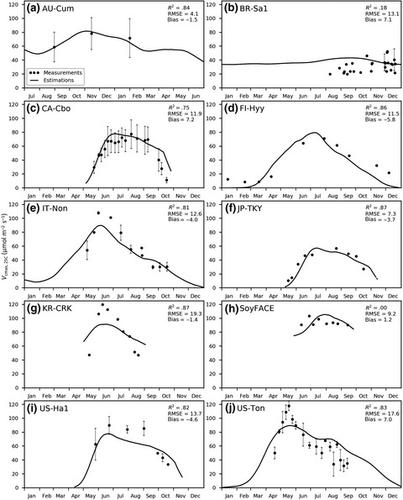当前位置:
X-MOL 学术
›
Glob. Change Biol.
›
论文详情
Our official English website, www.x-mol.net, welcomes your
feedback! (Note: you will need to create a separate account there.)
An optimality-based model explains seasonal variation in C3 plant photosynthetic capacity.
Global Change Biology ( IF 10.8 ) Pub Date : 2020-07-12 , DOI: 10.1111/gcb.15276 Chongya Jiang 1 , Youngryel Ryu 1 , Han Wang 2 , Trevor F Keenan 3, 4
Global Change Biology ( IF 10.8 ) Pub Date : 2020-07-12 , DOI: 10.1111/gcb.15276 Chongya Jiang 1 , Youngryel Ryu 1 , Han Wang 2 , Trevor F Keenan 3, 4
Affiliation

|
The maximum rate of carboxylation (Vcmax) is an essential leaf trait determining the photosynthetic capacity of plants. Existing approaches for estimating Vcmax at large scale mainly rely on empirical relationships with proxies such as leaf nitrogen/chlorophyll content or hyperspectral reflectance, or on complicated inverse models from gross primary production or solar‐induced fluorescence. A novel mechanistic approach based on the assumption that plants optimize resource investment coordinating with environment and growth has been shown to accurately predict C3 plant Vcmax based on mean growing season environmental conditions. However, the ability of optimality theory to explain seasonal variation in Vcmax has not been fully investigated. Here, we adapt an optimality‐based model to simulate daily Vcmax,25C (Vcmax at a standardized temperature of 25°C) by incorporating the effects of antecedent environment, which affects current plant functioning, and dynamic light absorption, which coordinates with plant functioning. We then use seasonal Vcmax,25C field measurements from 10 sites across diverse ecosystems to evaluate model performance. Overall, the model explains about 83% of the seasonal variation in C3 plant Vcmax,25C across the 10 sites, with a medium root mean square error of 12.3 μmol m−2 s−1, which suggests that seasonal changes in Vcmax,25C are consistent with optimal plant function. We show that failing to account for acclimation to antecedent environment or coordination with dynamic light absorption dramatically decreases estimation accuracy. Our results show that optimality‐based approach can accurately reproduce seasonal variation in canopy photosynthetic potential, and suggest that incorporating such theory into next‐generation trait‐based terrestrial biosphere models would improve predictions of global photosynthesis.
中文翻译:

基于最优性的模型解释了C3植物光合能力的季节性变化。
最大羧化速率(V cmax)是决定植物光合作用能力的重要叶片性状。现有的大规模估计V cmax的方法主要依赖于与代理的经验关系,例如叶氮/叶绿素含量或高光谱反射率,或者依赖于初级总产量或太阳诱导荧光的复杂逆模型。基于植物优化与环境和生长协调的资源投资的假设,一种新颖的机械方法已被证明可以根据平均生长季节环境条件准确预测C3植物的V cmax。但是,最优理论能够解释V的季节性变化cmax尚未得到充分调查。在这里,我们采用了基于最优性的模型来模拟每日V cmax,25C(标准温度为25°C时的V cmax),方法是融合前期环境的影响,这会影响当前工厂的功能以及动态光吸收,动态光吸收与植物功能。然后,我们使用来自不同生态系统的10个站点的季节性V cmax,25C现场测量值来评估模型性能。总体而言,该模型解释了10个地点的C3植物V cmax,25C的约83%的季节性变化,中均方根误差为12.3μmolm -2 s -1,这表明V cmax,25C的季节性变化与最佳植物功能一致。我们表明,如果不考虑对环境的适应或与动态光吸收的协调,则会大大降低估计精度。我们的结果表明,基于最优性的方法可以准确地再现冠层光合潜力的季节性变化,并表明将这种理论纳入下一代基于性状的陆地生物圈模型中,将改善全球光合作用的预测。
更新日期:2020-07-12
中文翻译:

基于最优性的模型解释了C3植物光合能力的季节性变化。
最大羧化速率(V cmax)是决定植物光合作用能力的重要叶片性状。现有的大规模估计V cmax的方法主要依赖于与代理的经验关系,例如叶氮/叶绿素含量或高光谱反射率,或者依赖于初级总产量或太阳诱导荧光的复杂逆模型。基于植物优化与环境和生长协调的资源投资的假设,一种新颖的机械方法已被证明可以根据平均生长季节环境条件准确预测C3植物的V cmax。但是,最优理论能够解释V的季节性变化cmax尚未得到充分调查。在这里,我们采用了基于最优性的模型来模拟每日V cmax,25C(标准温度为25°C时的V cmax),方法是融合前期环境的影响,这会影响当前工厂的功能以及动态光吸收,动态光吸收与植物功能。然后,我们使用来自不同生态系统的10个站点的季节性V cmax,25C现场测量值来评估模型性能。总体而言,该模型解释了10个地点的C3植物V cmax,25C的约83%的季节性变化,中均方根误差为12.3μmolm -2 s -1,这表明V cmax,25C的季节性变化与最佳植物功能一致。我们表明,如果不考虑对环境的适应或与动态光吸收的协调,则会大大降低估计精度。我们的结果表明,基于最优性的方法可以准确地再现冠层光合潜力的季节性变化,并表明将这种理论纳入下一代基于性状的陆地生物圈模型中,将改善全球光合作用的预测。











































 京公网安备 11010802027423号
京公网安备 11010802027423号